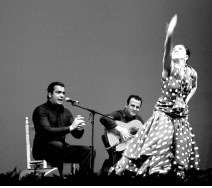Dizzying dance steps, captivating rhythms, stirring contrasts of red and black, all set against a background of abstract art - these are the elements of a spectacular performance of Spain's greatest gift to the world, flamenco dancing.
Organized by Spanish embassy and the Instituto Cervantes de Pekin, Flamenco Pa' Tos, or Flamenco for Everyone, brings Beijing a weeklong festival of films, performances and workshops dedicated to the art of flamenco from June 25 to July 1.
"Spanish culture has given the world everything from the poetry of Lorca to the genius of Picasso. But with the guitar and flamenco, Spain has given us her soul," said Elisa Reche Vicente from the Instituto Cervantes de Pekin. "This festival aims to bring flamenco nearer to China."
"Flamenco is mysterious; dances can express human feelings in a way other than language. The dances we bring this time are of the highest quality and impressiveness," introduced Vicente. "I think such an art form can go beyond cultural and region differences."
Guitarist Gerardo Nuez and dancer Carmen Corts, a famous couple, will bring the show Andando el tiempo (Walking the Time), offering the Chinese audiences a taste of their flamenco vision, a vision in which the traditional and the modern combine to perfection.
"Andando el tiempo is a music, song and dance show. It features songs from my latest album, choreographed by Carmen," the guitarist introduced. "It's a show that has been influenced by all the types of music we've been listening to and that we've liked."
The flamenco they are doing at the moment has a lot of roots and is very open. They use a lot of improvisation and music score, a series of chords that the musicians can use to improvise. "Maybe it's a system we've borrowed from our experience with jazz musicians," said Nuez. "Let's say it's very open and at the same time very flamenco."
Flamenco's roots trace back to the Gypsies of India. At the beginning of the 15th century, Indian Gypsies settled in Andalusia in Southern Spain. There, the new settlers lived peacefully and adjusted to Spanish life. But in 1492, all was changed.
That year, Spanish kings took control of Southern Spain. Anyone who didn't obey the new government was persecuted. So the people turned to music and dance to express their strong feelings of pain and depression. Gypsies and locals eventually merged their individual styles into one style -flamenco.
Besides the passionate flamenco dancing and music, there will be a chance for Chinese audiences to find out more about the gypsies. Flix Grande, winner of National Literature Prize 2004, a flamenco lover and prestigious flamenco critic, will be the curator of a collective photography exhibition themed on illustrating flamenco artists. The exhibition will feature works by photographers including Jos Daz-Maroto, Francisco Manzano, Shin Yamazawa, Jorge Snchez Fontaneda, Carlos Azorn and Joan Tomas.
Silvia Marn, director of the dance company El Flamenco Vive (Flamenco lives) will teach a Dance Workshop for Kids, which will focus on team work, a key element in flamenco dancing.
Salva del Real, guitarist, composer and singer, will be responsible for the guitar workshop. He has accompanied well-known flamenco singers, like La Paquera and Jos Merc, with his guitar.
The percussionist Sngel Snchez, known as Cepillo in the music world, will organize the percussion workshop. He has played with flamenco, rock, jazz, fusion artists and groups, like Tomatito, Duquende and Manolo Snlucar.
Another aspect of the festival will be the flamenco conferences delivered by Juan Verd, the artistic director of the festival; Juan Luis Cano, Gomaespuma radio program director; Gerardo Nnez, guitarist; and Felix Grande, poet and flamenco specialist.
The Instituto Cervantes de Pekin will also show flamenco-themed films, both documentaries and features about gypsy love, history and culture.
2007 also happens to be the "Year of Spain in China", when Spanish culture is introduced to Chinese people.
During the one-month long Seventh Meet in Beijing Arts Festival, which ran throughout May this year, Spanish dances performed at Beijing's Tianqiao Theater as the grand finale act of the closing ceremony.
The performance given by the Ballet Nacional De Espana (BNE), regarded as ambassadors of Spanish culture, presented Beijing citizens with a sumptuous Spanish feast for the eyes, including a demonstration of world famous flamenco dancing.
The Spanish troupe of dancers are already quite popular among the Beijing public. During the final show in particular, the passionate audience was amazed by the superb dance moves, and waves of applause rained down on the dancers throughout the night.
"Spain is a place where you can run with the bulls, nap in the afternoon and stay up all night listening to flamenco music in an ancient Moorish castle," said Vicente. "We want to bring the wonderful world here to Beijing."
Chen Nan
(China Daily 06/20/2007 page4)